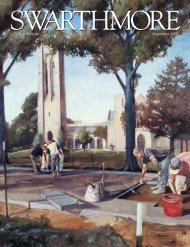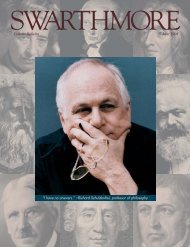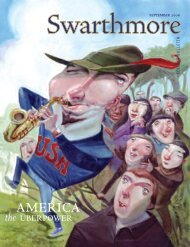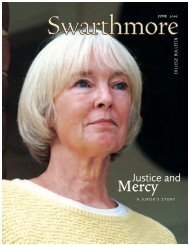A Walk in the Woods
Swarthmore College Bulletin (March 2001) - ITS
Swarthmore College Bulletin (March 2001) - ITS
You also want an ePaper? Increase the reach of your titles
YUMPU automatically turns print PDFs into web optimized ePapers that Google loves.
MARTIN NATVIGproblem with <strong>the</strong> results.”He<strong>in</strong>tz found m<strong>in</strong>ute variations <strong>in</strong> <strong>the</strong>sensitivity of <strong>the</strong> plates, caus<strong>in</strong>g <strong>the</strong> sizesof <strong>the</strong> images of Barnard’s Star and <strong>the</strong>stars with which Barnard’s was be<strong>in</strong>g comparedto vary slightly. He also questioned<strong>the</strong> precomputer ma<strong>the</strong>matical methodsthat Van de Kamp had used to <strong>in</strong>terpret hisdata—methods that He<strong>in</strong>tz claims were“too crude to remove small optical imag<strong>in</strong>gerrors.” Given that <strong>the</strong> marg<strong>in</strong> of error <strong>in</strong>determ<strong>in</strong><strong>in</strong>g a deviation was very narrow—with<strong>in</strong> 2 microns (far less than <strong>the</strong> diameterof a hair)—was it possible to concludethat a wobble existed at all?He<strong>in</strong>tz began to duplicate Van deKamp’s comparison studies and foundo<strong>the</strong>r variations <strong>in</strong> plates taken <strong>in</strong> <strong>the</strong>1940s and 1950s. He noted that, <strong>in</strong> 1949,<strong>the</strong> telescope had been disassembled andcleaned. Could <strong>the</strong> changes <strong>in</strong> <strong>the</strong> positionsof <strong>the</strong> lenses make it more likely for awobble to appear? In 1973, an astronomervisit<strong>in</strong>g <strong>the</strong> Sproul Observatory showedthat, <strong>in</strong> fact, this could have occurred.The most embarrass<strong>in</strong>g challenge didnot come from Swarthmore but from o<strong>the</strong>robservatories, which were follow<strong>in</strong>g scientificcustom by attempt<strong>in</strong>g to duplicate Vande Kamp’s work. After a decade of observ<strong>in</strong>gBarnard’s Star, none of <strong>the</strong>se observatoriesfound evidence of a planet.When He<strong>in</strong>tz mentioned to Van deKamp that he, too, was hav<strong>in</strong>g difficultyduplicat<strong>in</strong>g Van de Kamp’s work, “I wasdenounced among his friends—<strong>in</strong>clud<strong>in</strong>gtop adm<strong>in</strong>istrators—as a nasty characterand probably mentally disturbed,” He<strong>in</strong>tzV A N D E K A M P T H O U G H TT H A T T H E Q U I E T , S E R I O U SG E R M A N R E S E A R C HA S T R O N O M E RW O U L D F A I T H F U L L Y C A R R YO N H I S W O R K .H E N E V E R E X P E C T E DT H E C R I T I C I S M H E L A T E RG O T F R O M H E I N T Z ,W H I C H H E C O N S I D E R E DV E R Y D I S L O Y A L .“I CAN TELL YOU,” SAYS HEINTZ (SHOWNABOVE IN 1979), “I DID NOT WANT TOEMBARRASS A COLLEAGUE. I WAS NOTCOMFORTABLE AS THE [BEARER] OF BAD NEWS.THERE WAS NO SATISFACTION IN IT.I TOOK REFUGE IN MY OWN STUDIES, IN MYTEACHING, AND WITH THE TELESCOPE. IT’SSTILL QUITE A USEFUL INSTRUMENT.”THE 24-INCH REFRACTOR IS NOW USEDFOR VARIABLE STAR RESEARCH.remembers. “I was told that I should donoth<strong>in</strong>g about it, and that his observationswould eventually be confirmed. This Icould not believe because, with <strong>the</strong> variations<strong>in</strong> <strong>the</strong> exposures alone, <strong>the</strong>re did notseem to be enough to make any conclusionei<strong>the</strong>r way.”Any friendship between <strong>the</strong> two scientistsended when He<strong>in</strong>tz published <strong>the</strong> firstof a series of scientific papers on <strong>the</strong> subject<strong>in</strong> 1976. The papers shed <strong>the</strong> first publicdoubts on <strong>the</strong> accuracy of Van de Kamp’smethods.“It was <strong>the</strong> <strong>in</strong>terpretation that was atfault,” said Gaustad. “The effect hethought he saw was so small that it couldnot be dist<strong>in</strong>guished from <strong>the</strong> ‘noise’ <strong>in</strong> <strong>the</strong>measurement.“Van de Kamp felt betrayed. For <strong>the</strong>rema<strong>in</strong>der of his life, he <strong>in</strong>sisted that hisresults were correct and that he had founda planet. It’s important to keep <strong>in</strong> m<strong>in</strong>d,though, that, <strong>in</strong> terms of <strong>the</strong> rest of Van deKamp’s career, he did very important, accuratework, and that <strong>the</strong> field of astronomyis richer for it.”Still believ<strong>in</strong>g that he would one day bev<strong>in</strong>dicated, Van de Kamp returned toHolland <strong>in</strong> 1981. He died <strong>in</strong> 1995, a yearafter He<strong>in</strong>tz published his f<strong>in</strong>al word on<strong>the</strong> subject. After extensive remeasurementsof <strong>the</strong> Sproul plates and comparisonwith o<strong>the</strong>r telescopes’ results, He<strong>in</strong>tzdeclared <strong>in</strong> <strong>the</strong> Astronomical Journal thatVan de Kamp had been wrong.“Nowadays, when you hear aboutBarnard’s Star,” adds author Halpern, “it’salmost like a warn<strong>in</strong>g that th<strong>in</strong>gs that can’tbe wrong just might be wrong. In retrospect,what happened at Swarthmore tooksome of <strong>the</strong> st<strong>in</strong>g out of admitt<strong>in</strong>g a mistake.”In 1991, when British astronomerAndrew Lyne said—<strong>in</strong> error—that he’ddiscovered a planet orbit<strong>in</strong>g a pulsar, heannounced his mistake at a meet<strong>in</strong>g of <strong>the</strong>American Astronomical Society soon afterwardand was given a stand<strong>in</strong>g ovation.“What I did,” He<strong>in</strong>tz says, “was showthat you can’t use photography to look forplanets.”In <strong>the</strong> past decade, us<strong>in</strong>g entirely differentmethods and <strong>in</strong>struments, scientistshave found some 30 stars with planetsorbit<strong>in</strong>g around <strong>the</strong>m. TJournalist and novelist Bill Kent is a frequentcontributor to <strong>the</strong> Bullet<strong>in</strong>.M A R C H 2 0 0 131
















